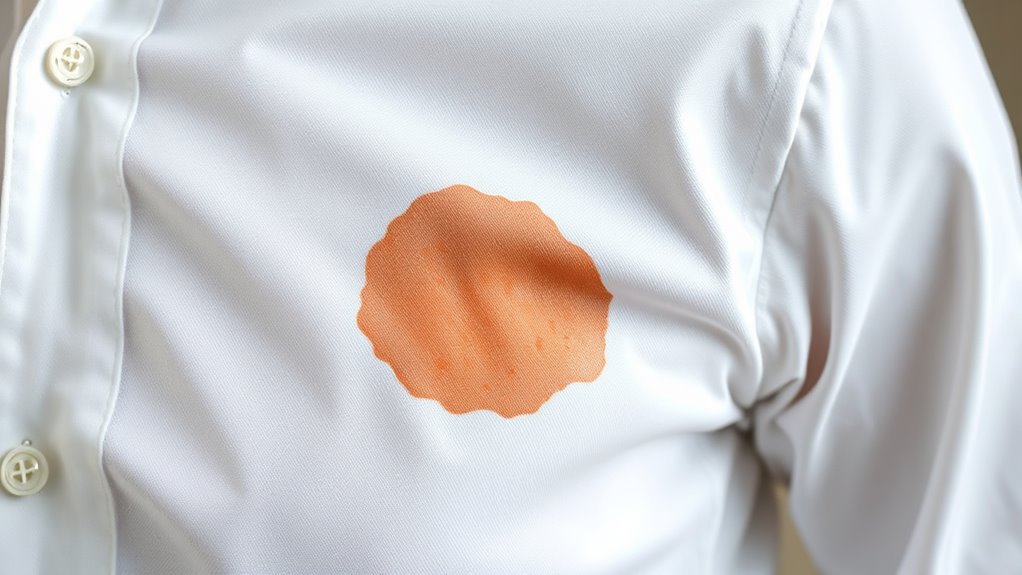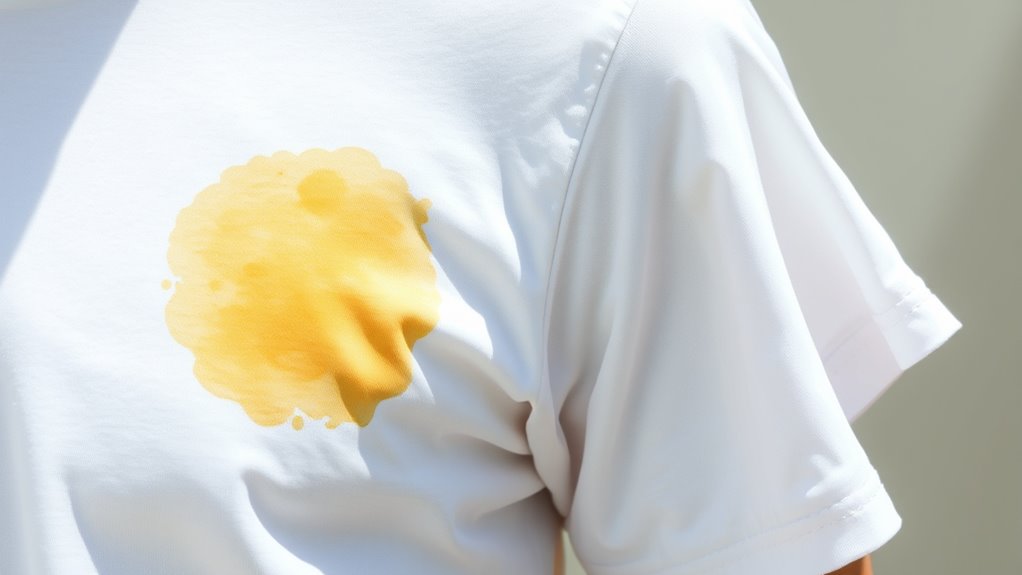To prevent sweat stains, apply antiperspirant at night and choose breathable fabrics like cotton or linen. Treat existing stains early with baking soda, vinegar, or commercial stain removers, and wash shirts in cold water to stop them from setting. Use sweat-absorbing undershirts or pads and avoid heat from dryers until stains are gone. Consistent habits and smart choices help keep your shirts stain-free—continue exploring for more practical tips to stay fresh and stain-free.
Key Takeaways
- Use antiperspirants at night and natural remedies to reduce sweat and odor naturally.
- Choose breathable, dark-colored clothing and sweat-proof undershirts to prevent stains.
- Pre-treat stains immediately with baking soda, vinegar, or stain removers, and wash in cold water.
- Avoid drying stained shirts with heat until stains are fully removed to prevent setting.
- Maintain a consistent routine of prevention and treatment to keep shirts stain-free long-term.

Are sweat stains ruining your favorite shirts? If you find yourself constantly battling underarm stains and persistent odors, it’s time to explore effective solutions. The first step is understanding your antiperspirant options. Over-the-counter antiperspirants contain aluminum compounds that temporarily block sweat glands, reducing the amount of sweat that reaches your skin’s surface. Applying antiperspirants at night can be especially effective because it gives the ingredients time to work while your sweat glands are less active. For those who prefer a more natural approach, natural remedies like witch hazel, apple cider vinegar, or baking soda can help manage sweat and odor without harsh chemicals. These options not only minimize sweat but also keep your skin healthy, especially if you have sensitive skin.
Combat sweat stains with natural remedies and proper antiperspirant use for healthier, stain-free shirts.
If you’re looking to prevent sweat stains before they appear, choosing the right clothing can make a big difference. Opt for loose-fitting, breathable fabrics like cotton or linen, which allow air to circulate and help keep your body cool. Wearing darker colors can also hide any sweat marks, giving you confidence throughout the day. Additionally, using sweat-proof undershirts or pads can absorb excess moisture and protect your outerwear from staining. These small adjustments can markedly reduce the likelihood of visible stains, especially during hot weather or intense activity.
Treating existing sweat stains requires a targeted approach. As soon as you notice a stain, pre-treat it with a mixture of baking soda and water or a stain remover designed for sweat marks. For stubborn stains, soaking your shirts in a solution of white vinegar and water can help break down the sweat minerals and deodorize the fabric. Always wash your shirts in cold water, as hot water can set stains permanently. Avoid drying stained shirts in the dryer until you’re sure the stain is gone; heat can lock in the stain, making it much harder to remove later. Repeating the treatment process may be necessary if the stain persists. Incorporating a brief rendering of fat like homemade lard into your cooking routine can also promote overall health, which may indirectly influence sweat and odor.
To prevent future stains, consider incorporating a routine of applying antiperspirant at night and staying mindful of your clothing choices. Natural remedies can be a gentle, effective alternative to traditional antiperspirants, especially if you’re prone to skin irritation. Remember, consistency is key—regular care and smart wardrobe choices can keep sweat stains in check. With a mix of preventative measures and effective treatments, you’ll be able to enjoy your favorite shirts without worry, repeating these steps whenever necessary to keep sweat stains at bay.
Frequently Asked Questions
Can Natural Remedies Effectively Remove Persistent Sweat Stains?
Natural remedies can help with persistent sweat stains, especially when you use aromatherapy techniques and herbal extraction methods. You might find that essential oils like tea tree or lavender, applied with proper dilution, can deodorize and brighten fabrics. However, for stubborn stains, these methods may work best alongside conventional treatments. Always test a small area first, and remember, consistency is key to seeing results with natural solutions.
How Do Fabric Types Influence Sweat Stain Treatment Options?
Fabric flexibility and colorfast fabrics profoundly influence sweat stain treatment options. Flexible fabrics often absorb more, making stains stubborn, while stiff fabrics resist penetration. Colorfast fabrics tolerate stronger solutions without fading, unlike delicate or non-colorfast materials that require gentle treatment. You should match your method to your fabric type, choosing delicate cleansers for sensitive textiles and robust remedies for sturdy, colorfast fabrics, ensuring effective stain removal without damage.
Are There Environmentally Friendly Products for Sweat Stain Prevention?
You’re asking if eco-friendly products can prevent sweat stains. The good news is, many eco-friendly detergents and plant-based stain removers are designed to be gentle on fabrics while effectively reducing sweat stains. By choosing these products, you help protect the environment and your clothes. Just look for labels that specify eco-friendly, biodegradable, or plant-based ingredients to confirm you’re making a sustainable choice.
What Are the Long-Term Effects of Various Sweat Stain Treatments?
Imagine applying a treatment and forgetting about it, only to wonder later about its long-term effects. Some sweat stain treatments can leave chemical residues on your skin, potentially causing sensitivities over time. While many products are safe, repeated use might lead to irritation or allergic reactions. It is crucial to choose gentle, skin-friendly options and monitor any changes, ensuring your skin stays healthy even with ongoing treatment.
How Do Diet and Hydration Impact Sweat Stain Formation?
You might wonder how diet and hydration impact sweat stain formation. Your hydration levels influence how much you sweat, with dehydration causing more concentrated sweat that stains more easily. Dietary choices, like consuming spicy foods or caffeine, can increase sweat production and odor. Staying well-hydrated and choosing balanced, non-irritating foods help reduce the likelihood of visible stains, keeping your clothing cleaner and fresher longer.
Conclusion
Now you know how to prevent and treat sweat stains effectively. By staying proactive and following these simple tips, you’ll keep your clothes looking fresh and clean longer. It’s true—consistency is key. If you act quickly, you can stop stains before they set in. So, embrace these solutions and don’t let sweat stains ruin your day. With a little effort, you’ll stay confident and stain-free, no matter what life throws at you.









